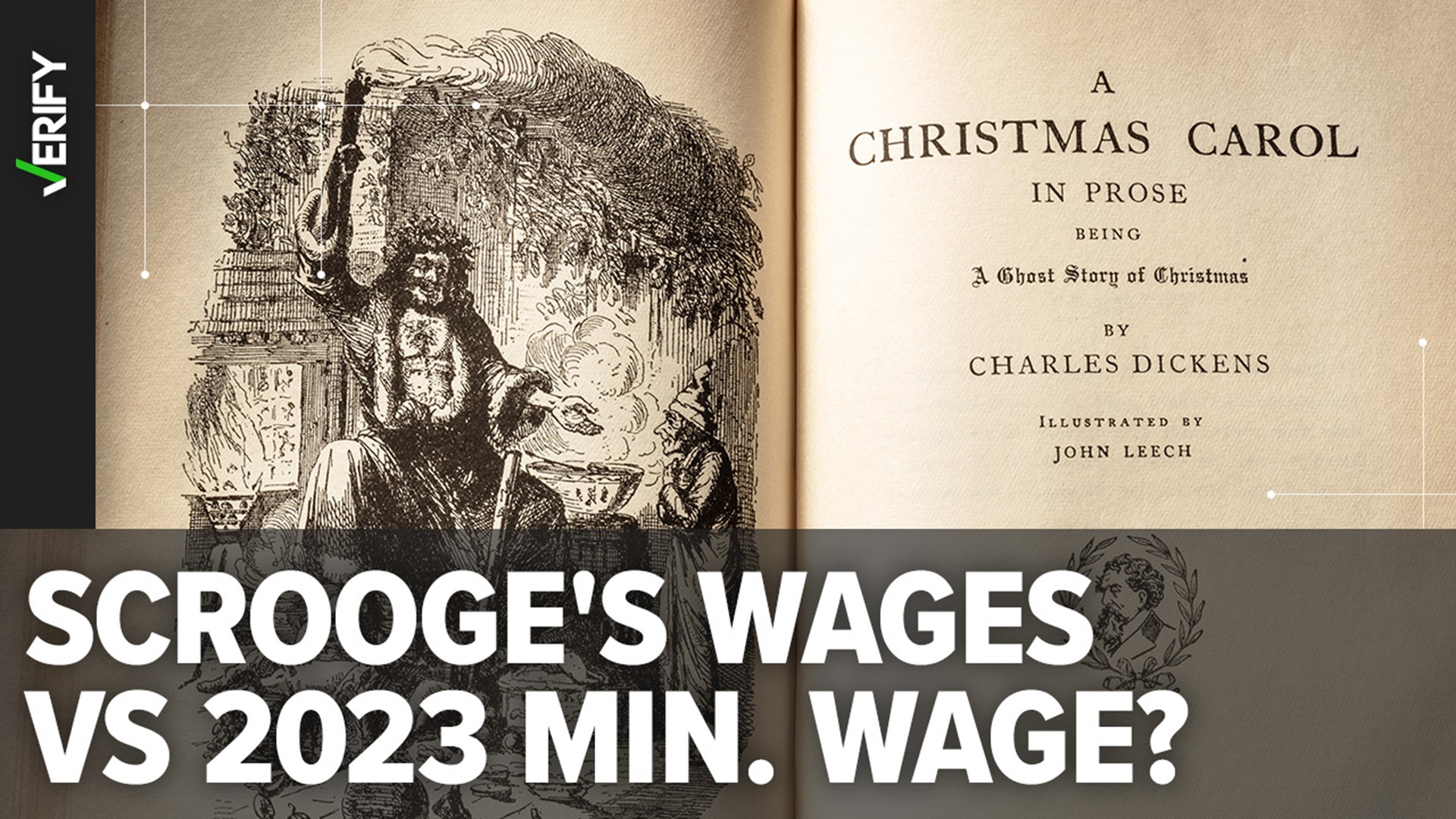Charles Dickens’ 1843 novel, A Christmas Carol, famously promotes generosity and kindness during the holiday season. It tells the story of a miserly man named Ebenezer Scrooge who experiences overnight visits from four ghosts on Christmas Eve to encourage him to be a kinder, more generous man.
Numerous social media posts over the last several years have compared the salary of Scrooge’s underpaid and overworked employee, Bob Cratchit, to today’s minimum wage. The posts claim Cratchit’s 15 shillings-a-week pay, when adjusted for inflation, is higher than the current federal minimum wage of $7.25/hour.
THE QUESTION
Did Ebenezer Scrooge pay Bob Cratchit more in inflation-adjusted wages than the current federal minimum wage?
THE SOURCES
MeasuringWorth Foundation, a non-profit corporation that is run by economics professors at various universities
THE ANSWER
Depending on how you calculate it, Cratchit’s 15 shillings a week can fall below or above federal minimum wage when adjusted for inflation. He makes about $1.50 per hour based on one calculation, and about $12.60 per hour based on another calculation.
WHAT WE FOUND
According to A Christmas Carol, which was written in 1843, Scrooge paid Cratchit 15 shillings a week.
There are several ways to convert that to a comparable 2023 dollar amount. But keep in mind, comparisons of prices and wages further back in time and over longer periods of time are less accurate than comparisons over shorter periods in more recent years, according to the Bank of England.
The simplest method calculates the value of the pound based on its rough buying power for goods and services, which is typically how inflation is measured. The other method calculates how a wage compares to the average worker’s wage of its time.
The goods and services a typical family might buy today are very different from what they’d buy 150 years ago, the Bank of England says. Changes in technology, society and available income all impact what a typical family might buy from one generation to the next. These changes mean that both methods of comparison are ultimately imperfect, even if they’re the best methods for estimating the value of money then as it compares to now.
We did the math for both methods.
Inflation price calculator (simple method)
The Bank of England has an inflation calculator that allows you to see how prices have changed in the United Kingdom between the year 1209 and now. The calculator attempts to take into account the differences between the goods and services purchased over time.
This calculator, which only measures price inflation over time, is the simplest way to calculate how much Cratchit’s 15 shillings a week wage would be worth in today’s dollars.
In 1843, there were 20 shillings in a pound, the Royal Mint Museum says. That means that 15 shillings a week were equivalent to 0.75 pounds a week.
According to the Bank of England’s calculator, .75 pounds in 1843 is equivalent to 78.54 pounds today.
There are two ways you can turn that weekly wage into an hourly wage. If you assume Cratchit worked as much as a modern worker, then you divide the weekly wage by 40. That gives you an hourly wage of 1.96 pounds per hour. Based on today’s exchange rate, that would be $2.48/hour.
But the length of the average British work week in 1843 was 65 hours, according to the Federal Reserve Bank of St. Louis. If you divide Cratchit’s weekly wage by 65 hours, you get an hourly wage of 1.21 pounds per hour, or $1.53/hour.
Either way, that’s less than the U.S. federal minimum wage of $7.25/hour. However, the Bank of England does not recommend you calculate the value of wages in this way.
Relative labor earnings
The Bank of England says a calculator based on average earnings might be a better choice to compare wages, income or wealth over time. It refers to a website called measuringworth.com for this calculator.
The MeasuringWorth Foundation is a nonprofit corporation that is run by economics professors at various universities.
According to the MeasuringWorth Foundation, a measure it calls “relative labor earnings” is the best measure of a wage or salary compensation. Relative labor earnings takes a wage and compares it to the wage of an average worker from that same year, and then applies the result to the wage of an average worker today.
The relative labor earnings of 15 shillings in 1843 is equivalent to 647 pounds today, according to MeasuringWorth’s calculator.
Again, how that translates into hourly wages depends on whether you assume Cratchit worked 40 hours a week or 65 hours a week.
If Cratchit worked 40 hours a week, then his weekly wage translates to 16.18 pounds per hour, or $20.49/hour.
If Cratchit worked 65 hours a week, which is more likely considering he was overworked during a time in which workers were expected to work more than 60 hours a week, then his weekly wage translates to 9.95 pounds hour, or $12.60/hour.
Possible range
So, to recap, depending on how the wages are calculated, Bob Cratchit made between $1.53 and $12.60 per hour in today’s terms.
Today’s wages
While the federal minimum wage is $7.25/hour, individual states are allowed to set higher minimum wages for their workers.
According to the U.S. Department of Labor, 14 states plus Washington, D.C., have minimum wages higher than $12.60/hour. The highest minimum wage is $16.50/hour in Washington, D.C.
A Christmas Carol mentions that Cratchit has seven family members: a wife and six children. Bob is the only one currently earning a wage at the time the story takes place, which was not uncommon for the time.
The federal poverty level for a family of eight in 2023 is $50,560, according to the U.S. Department of Health and Human Services (HHS). All of the wages calculated above fall below that mark; Cratchit would make $42,619.20 a year if he earned $20.49/hour.
In other words, even the most generous calculations still have the character living in poverty.

